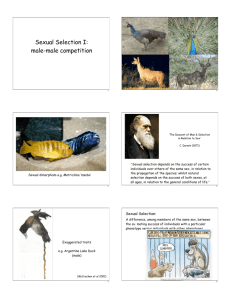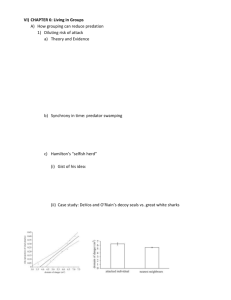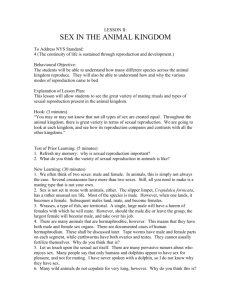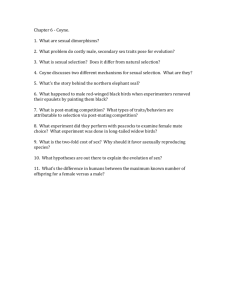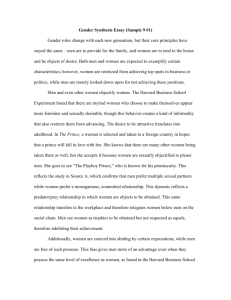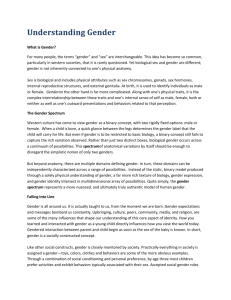Sexual Selection.key - Evolutionary Biology at the Zoological Institute
advertisement
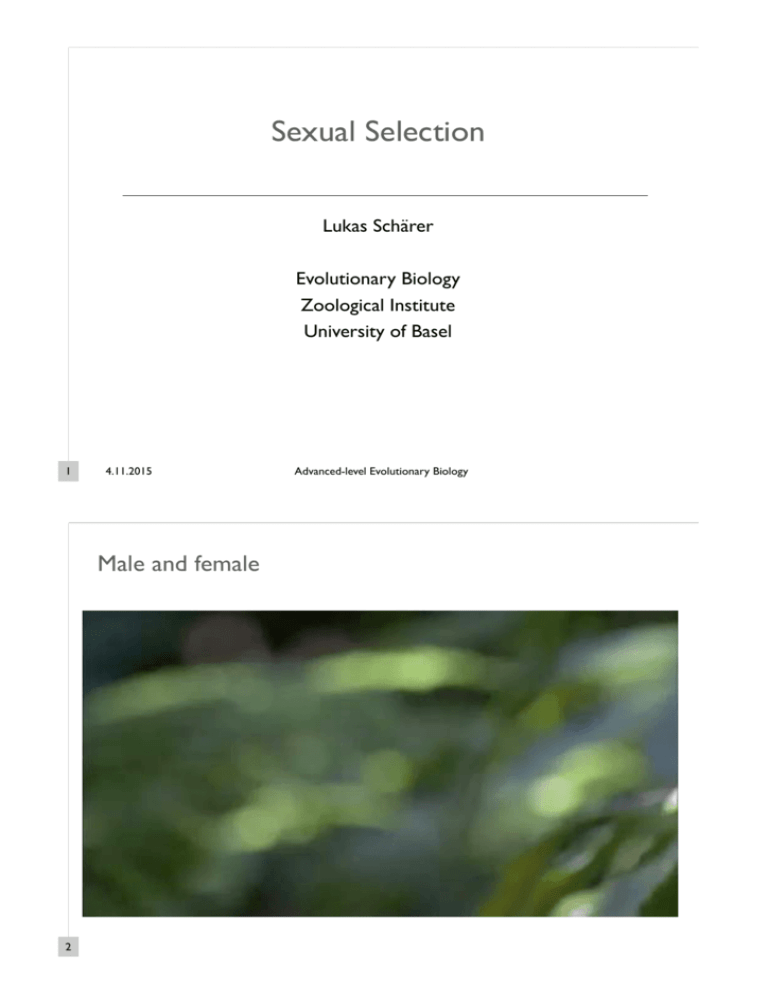
Sexual Selection Lukas Schärer ! Evolutionary Biology Zoological Institute University of Basel 1 4.11.2015 Male and female 2 Advanced-level Evolutionary Biology Summary: Sexual Selection • defining sexual selection • mating systems • measuring sexual selection • models of sexual selection • male-male competition and female choice • sperm competition and cryptic female choice 3 Defining sexual selection • Darwin’s definitions • ‘(sexual) selection depends, not on a struggle for existence in relation to other organic beings or to external conditions, but on a struggle between the individuals of one sex, generally the males, for the possession of the other sex. The result is not death to the unsuccessful competitor, but few or no offspring. ‘ Darwin (1859) in: On the Origin of Species by Means of Natural Selection ! • ‘(sexual selection) depends on the advantage which certain individuals have over others of the same sex and species solely in respect to reproduction’. Darwin (1871) in: The Descent of Man and Selection in Relation to Sex 4 Defining sexual selection • sexual selection is a component of natural selection note that mating success does not have to be tightly correlated with fertilisation success 5 from Arnqvist & Rowe 2005 Defining sexual selection • Bateman’s principle (like many ‘principles’ only a rule of thumb) • in a female, reproduction tends to be limited by the number (and quality) of eggs she produces, which is often limited by the amount of resources she has available • in a male, reproduction tends to be limited by the number (and quality) of eggs he fertilises, which is often limited by the number of females he can mate with 6 from Bateman 1948 Defining sexual selection • Darwin (1871) defined two basic types of sexual selection ! • intrasexual selection (generally seen as male-male competition) • ‘in the one it is between individuals of the same sex, generally the males, in order to drive away or kill their rivals, the females remaining passive’ • intersexual selection (generally seen as female choice) • ‘whilst in the other the struggle is likewise between the individuals of the same sex, in order to excite or charm those of the opposite sex, generally the females, which no longer remain passive, but select the more agreeable partners’ 7 Defining sexual selection • female choice (female preference, mating bias) • any female trait (e.g., behaviour, morphology or physiology) that influences the reproductive success of certain males based on their phenotype • does not need to be a conscious decision • does not have to increase female fitness • the same may apply to male choice and there probably often is mutual mate choice 8 Mating systems • the “mating system” concept aims to broadly classify how males and females interact sexually Cygnus buccinator ! • monogamy • each sex has a single mate for life • polygyny • females mate with a single male, but males mate with more than one female (lekking or haremic systems) Mirounga angustirostris • polyandry • males mate with a single female, but females mate with more than one male (sex-role reversal) Phalaropus lobatus • polygamy • both sexes have several partners and approximately equal variation in mate numbers Thalassoma bifasciatum 9 Mating systems • feeding-dependent mating system in a bushcricket 10 from Gwynne & Simmons 1990 Mating systems • social mating system ≠ genetic mating system red-winged blackbird (Agelaius phoeniceus) 11 Measuring sexual selection • sexual selection needs to be measured quantitatively Variance 12 from Arnqvist & Rowe 2005 Measuring sexual selection • variance in reproductive success in red deer (Cervus elaphus) % of males % of females • what are the traits that determine where an individual is in this distribution? • are those traits expressed in males or females or both? • how do such traits originate and evolve? 13 Models of sexual selection • Fisherian runaway process (think ‘sexy sons’) • females prefer a random male trait, and the offspring inherit both the trait and the preference for the trait • what is the origin of the trait and the preference? • the resulting genetic correlation can lead to a runaway process, which is eventually stopped if the costs get too high, due to e.g. • direct viability selection on the male trait • viability selection on correlated traits in female (leads to sex-limited expression!) • costs of female choice 14 from Stearns & Hoekstra 2005 Models of sexual selection whitefish (Coregonus sp.) • handicaps, indicators and good genes • the females prefer males with traits that indicate good genetic quality, and the offspring inherit these good genes and the preference • but quality is expected to be already under directional selection, and so it is unclear what maintains the variation in male quality within the population 15 from Wedekind et al. 2001 Models of sexual selection • direct effects • females prefer males that provide material benefits (e.g., a nuptial gift, a good territory or sufficient sperm) • these benefits may either be measured directly or based on a trait correlated with them • usually do not lead to extreme traits the dance fly (Rhamphomyia sulcata) 16 from LeBas & Hockham 2005 Models of sexual selection • sensory exploitation • males exploit an existing sensory bias in females (e.g., a preference for red dots, because the females eat red berries) • this can be the starting point of a Fisherian runaway process • the females can’t easily evolve resistance against this kind of exploitation (e.g. because they still need to find red berries) • please note that the berry example is only a thought experiment! 17 from Basolo 2002 Male-male competition and female choice • intrasexual selection (male-male competiton) • contest competition • rivals physically compete for the mating partner • scramble competition • rivals compete via agility or speed • endurance rivalry • rivals compete through endurance • intersexual selection • female preference for condition and parasite resistance • females choose a good quality male • female preference for an exaggerated trait • females chose based on an extended phenotype • female preference for complementarity • females choose the right partner given their own genetic composition (i.e. there is no overall best male!!) 18 Intrasexual selection • contest competition in the dung beetle genus Onthophagus • males fight with their horns and females mate with the winner 19 Intrasexual selection • horn size and shape varies greatly between species back of the head middle of the head front of the head center of the pronotum sides of the pronotum 20 from Emlen et al. 2005 21 22 from Emlen et al. 2005 from Emlen et al. 2005 Intersexual selection • female preference for a complementary MHC genotype • the MHC is important for antigen presentation in the immune system 23 Intersexual selection • when women were asked to rank the pleasantness and attractiveness of t-shirts worn by men the MHC dissimilar men were more attractive • the preference was found to depend on whether the women were taking the contraceptive pill • modern contraceptive pills use different hormones and/or formulations 24 from Wedekind et al. 1995 Male-male competition and female choice • sexual selection occurs at both the pre- and postcopulatory level • Darwin may not have realised that the second level can be important and assumed that the number of matings is a good proxy for reproductive success • pre- and post-copulatory sexual selection can be linked • in the scorpion fly (Hylobittacus apicalis) bigger nuptial gifts lead to longer copulations and greater sperm transfer, which is advantageous under conditions of sperm competition 25 from Krebs and Davies 1993 after Thornhill 1976 Sperm competition and cryptic female choice • definitions of sperm competition by Parker • ‘competition within a single female between the sperm of two or more males for the fertilisation of the ova’ • Parker (1970) in: Sperm competition and its evolutionary consequences in the insects. Biological Reviews 45: 525-567. • ‘competition between the sperm of two or more males for the fertilisation of a given set of ova’ • Parker (1998) in: Birkhead & Møller (eds.). Sperm Competition and Sexual Selection. San Diego, CA, USA: Academic Press. ! • do not try to think of fighting sperm, but rather of competition between different ejaculates 26 Sperm competition and cryptic female choice • expenditure on gaining matings or ejaculates 27 from Parker 1998 Sperm competition and cryptic female choice • the evolution of testis size in primates 28 from Dixson & Anderson 2002 Sperm competition and cryptic female choice • definitions of cryptic female choice • ‘a female-controlled process or structure that selectively favours paternity by conspecific males with a particular trait over that of others that lack the trait when the female has copulated with both types’. Eberhard (1996) in: Female Control: Sexual Selection by Cryptic Female Choice. Princeton University Press • ‘non-random paternity biases resulting from female morphology, physiology or behaviour that occur after coupling’. Pitnick & Brown (2000) in: Criteria for demonstrating female sperm choice. Evolution 54: 1052-1056 ! • again, this does not have to be a conscious choice 29 Sperm competition and cryptic female choice • sperm rejection by domestic chicken • chicken reject sperm by subdominant males 30 from Pizzari & Birkhead 2000 Summary: Sexual Selection • defining sexual selection • mating systems • measuring sexual selection • models of sexual selection • male-male competition and female choice • sperm competition and cryptic female choice 31 Literature • Mandatory Reading • Pages 10-21 in Chapter 1 of Birkhead (2000). Promiscuity: an Evolutionary History of Sperm Competition. Harvard University Press • Suggested Reading • Chapter 11 on ‘Sexual Selection’ in Stearns & Hoekstra (2005). Evolution: An Introduction. 2nd Edition. Oxford University Press • Chapter 20 on ‘Sexual Selection’ by Jennions and Kokko (2010) in ‘Evolutionary Behavioral Ecology’ (Westneat and Fox, eds.) • Books • Birkhead (2000). Promiscuity: an Evolutionary History of Sperm Competition. Harvard University Press 32
